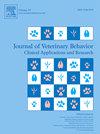Effects of two types of environmental enrichment on the behavior of dogs in shelters
IF 1.3
3区 农林科学
Q4 BEHAVIORAL SCIENCES
Journal of Veterinary Behavior-clinical Applications and Research
Pub Date : 2025-07-01
DOI:10.1016/j.jveb.2025.05.004
引用次数: 0
Abstract
The domestic dog, Canis lupus familiaris, is commonly kept in shelters. In these locations, features such as confinement, forced intraspecific and interspecific contact, and lack of environmental stimulation can diminish the welfare of dogs. One way to avoid poor welfare is to implement an environmental enrichment program for dogs in shelters, however, environmental enrichment items should be tested to evaluate their effectiveness and their ease of implementation and safety. Therefore, this study aimed to evaluate the effectiveness of two environmental enrichment items designed to improve the welfare of dogs kept in a shelter. Fifteen dogs, housed in trios, were studied. Two environmental enrichment items were offered to the dogs: nutritional-related (perforated plastic bottles filled with canine treats) and sensory-related (lavender oil). Behavioral data were collected before, during, and after the items were offered, using focal sampling and instantaneous recording methods, with a sampling interval of 1 min. The effectiveness of the items was evaluated using Generalized Linear Mixed Models (GLMMs). Food enrichment increased foraging and activity behaviors in the dogs, but not positive social behaviors. On the other hand, olfactory enrichment decreased jumping and vocalizing and increased the display of climbing on the pen’s door. Both items proved to be safe for the dogs. It is of utmost importance for shelters to enhance animal welfare by constructing larger and more stimulating bays and implementing environmental enrichment programs for the animals. The results of this study show that an enrichment program can assist in improving the welfare of dogs kept in shelters.
两种环境富集对收容所中犬类行为的影响
家犬狼狗(Canis lupus familiaris)通常被养在收容所。在这些地方,诸如禁闭、强迫种内和种间接触以及缺乏环境刺激等特征会降低狗的福利。为避免福利不佳,可以对收容所里的狗实施环境强化项目,但环境强化项目必须经过测试,以评估其有效性、实施的便利性和安全性。因此,本研究旨在评估两种环境富集项目的有效性,这些项目旨在改善收容所养狗的福利。研究人员对15只狗进行了研究。给狗提供了两种环境富集物品:营养相关(装满狗粮的穿孔塑料瓶)和感官相关(薰衣草油)。行为数据采集在提供物品之前、期间和之后,采用焦点采样和瞬时记录的方法,采样间隔为1 min。采用广义线性混合模型(glmm)评价项目的有效性。食物丰富增加了狗的觅食和活动行为,但没有积极的社会行为。另一方面,嗅觉增强减少了跳跃和发声,增加了攀爬在围栏门上的显示。事实证明,这两种食物对狗都是安全的。对于动物收容所来说,通过建造更大、更刺激的海湾和实施环境丰富计划来提高动物福利是至关重要的。这项研究的结果表明,一个富集计划可以帮助改善收容所的狗的福利。
本文章由计算机程序翻译,如有差异,请以英文原文为准。
求助全文
约1分钟内获得全文
求助全文
来源期刊
CiteScore
3.50
自引率
16.70%
发文量
107
审稿时长
325 days
期刊介绍:
Journal of Veterinary Behavior: Clinical Applications and Research is an international journal that focuses on all aspects of veterinary behavioral medicine, with a particular emphasis on clinical applications and research. Articles cover such topics as basic research involving normal signaling or social behaviors, welfare and/or housing issues, molecular or quantitative genetics, and applied behavioral issues (eg, working dogs) that may have implications for clinical interest or assessment.
JVEB is the official journal of the Australian Veterinary Behaviour Interest Group, the British Veterinary Behaviour Association, Gesellschaft fr Tierverhaltensmedizin und Therapie, the International Working Dog Breeding Association, the Pet Professional Guild, the Association Veterinaire Suisse pour la Medecine Comportementale, and The American Veterinary Society of Animal Behavior.

 求助内容:
求助内容: 应助结果提醒方式:
应助结果提醒方式:


